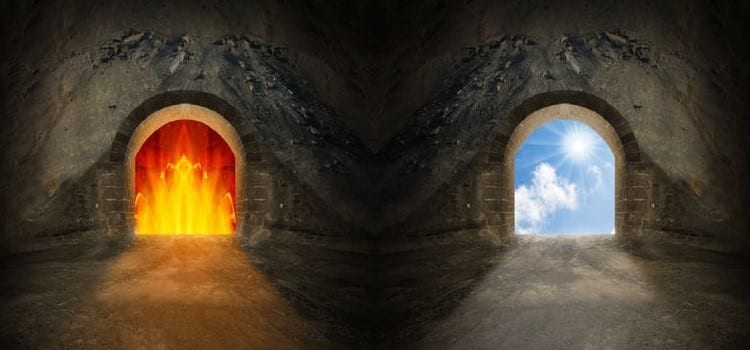During the time that Shakespeare and his contemporary playwrights were writing their plays beliefs about good and evil were changing. In the mediaeval mind good came from God and evil came from the Devil. It was more or less as simple as that. Human beings had no say in the matter and good and evil were things that were imposed on them. When someone behaved well s/he was being influenced by God and when someone behaved badly they were under the power of the Devil, sometimes even possessed by his demons.
With the Renaissance, and the humanism that was influencing the cultural and artistic outlook of Europe, a more psychological concept of good and evil began to come into being. Human beings were now responsible for their actions and the good or evil within them originated in people rather than in outside agents. That transformed the drama of the Renaissance and instead of the stock, stereotypical figures of mediaeval drama, we now began to see characters who were ‘good’ or ‘evil’, or even a mixture of the two. The audience could see them as real people like themselves and were able to become involved in their feelings and emotions, rather than just regard them as one would gaze at stuffed animals in a glass case. That was, of course, one of the main reasons for the popularity of the Renaissance theatre.
And so, Shakespeare and his contemporaries could create really evil characters like Iago who, in spite of a level of evil that most audiences still gasp at, they could recognise as being real people like them. Conversely, a character like Desdemona, sweet and innocent, putting herself last in her service to others, admirable and enviable as she is to us, who could never be like her, is nevertheless recognisable as a real person like us.
As humanism took root in Europe, conditioned by such things as the growth of individual wealth and criticism of religious institutions, the distinction between good and evil began to disappear, allowing true psychological characters who were capable of both good and bad actions to emerge in drama, just as figures in art and sculpture were becoming more naturalistic. And so we have the physically realistic figure of Michelangelo’s David and the psychologically realistic figure of Edmund in King Lear. And we have a hero like Macbeth who can be turned from good to evil.
There was still an objective evil lingering in the real world of human beings, mainly in the form of witches. Witches, influencing human beings and seducing them into committing evil deeds, feature in Renaissance drama. Audiences were fascinated by them so they made good material for drama. The combination of the Devil’s agents at work and psychological characters struggling against their influence could form the conflict in the drama, and so we had a play like Macbeth.
Macbeth is a good example of the treatment of good and evil in both Elizabethan drama and Jacobean drama. As a theme it is a stark contrasting picture of the two forces, perhaps even over-simple. But it’s that contrast that provides the drama, with all the language and action surrounding them.
Macbeth begins as a ‘good’ man, a very good man – loyal, responsible and honourable. During the course of the action he becomes evil, influenced by the witches who are agents of the power of evil. He is led on by their suggestion that he is destined to become king. The transition is accompanied by language that depicts that transition. At first he is ‘great,’ ‘good,’ Macbeth, the hero of Scotland. The king, Duncan, calls him ‘valiant cousin,’ and ‘worthy gentleman.’ In the course of the action Macbeth kills his opponents, slaughtering the whole of Macduff’s family, one of the children actually being murdered onstage. He is now ‘black Macbeth,’ ‘bloody butcher,’ ‘hell kite.’
The saintly Duncan is associated with good. When Macbeth is considering killing him he acknowledges that: ‘this Duncan hath borne his faculties so meek… that his virtues will plead like angels trumpet-tongued against the deep damnation of his taking off.’ We see there the direct contrast in the angels of heaven and the damnation of hell.
As Duncan and Banquo approach Macbeth’s castle for the king’s visit, the language creates a heavenly atmosphere around them: ‘heaven’s breath smells wooingly here.’ But inside the castle it is different. The evil plotting of Macbeth and Lady Macbeth has turned it into an almost literal hell. ‘The raven himself is hoarse that croaks the fatal entrance of Duncan under my battlements,’ Lady Macbeth says. ‘Come thick night and pall thee in the dunnest smoke of hell.’ Everything now, in the castle, is dark and hellish. There is even a comic scene, after the killing of Duncan, where the gate keeper, aroused from his sleep by Macduff knocking on the door, fantasises about being the gatekeeper of hell. Every word, every action, now, expresses that theme.
Duncan’s son, Malcolm, together with Macduff, exiled in England, now gathers a force to return to Scotland and overthrow Macbeth. Sponsored by the English king, who is depicted as the agent of good, they return to Scotland and the classic battle of good versus evil takes place. They overthrow Macbeth and the throne is restored to its rightful king. Good has triumphed over evil.
Most of the plays have this tension between good and evil but none as clearly and graphically and prominently as Macbeth.

Good vs evil – a classic play theme




Leave a Reply
Want to join the discussion?Feel free to contribute!